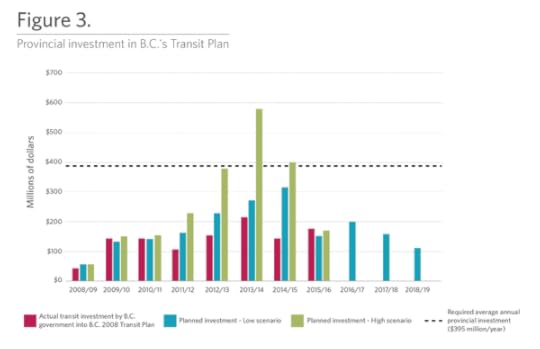David Suzuki's Blog, page 33
June 27, 2016
How to fend off mosquitoes
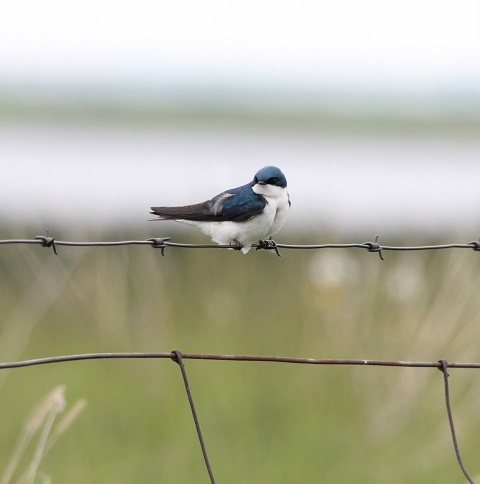
Attract mosquito-eating chickadees, house wrens, bluebirds, swallows and martins with birdhouses and bird baths. (Credit: James Andruchow)
As an Alberta girl, I know mosquitoes.
I also spent five summers working in the boreal forest counting critters -- and inadvertently feeding skeeters, no-see-ums and deer and horse flies.
Bug spray ingredients often don't break down. Some linger and can cause harm to plants and animals other than their targets. Avoid DEET and you'll never rinse it into our oceans, lakes or rivers.
Before you reach for a DEET bug repellent, try these non-toxic tips to make you and your home less attractive to mosquitoes:
Remove standing water (mosquito breeding grounds). Refresh bird and bee baths daily.
Fill, cover or remove backyard items that collect water -- empty planters, kids' toys, wheelbarrows, etc.
Keep gutters clean to help rainwater flow freely.
Repair screens on doors and windows.
Keep grass to about three inches. Trim shrubs.
Attract mosquito-eating chickadees, house wrens, bluebirds, swallows and martins with birdhouses and bird baths.
Avoid synthetic fragrances. Mosquitoes love scents in soaps, lotions, shampoos, perfumes and laundry detergent.
Cover up with long sleeves, long pants and socks.
Wear light-coloured, loose-fitting, long-sleeved shirts, long pants and socks. Tuck kids' pants into their socks for extra protection.
When you go camping, take a bug net (for your head) and bug shirt. They will keep you sane.
Try herbal repellents with citronella, cedar, eucalyptus, lemongrass or peppermint essential oils. They're safer for children (but not on babes under two years). The Centre for Disease Control found some products with offer long-lasting protection (but not recommended for children under three). (Note: They also recommend DEET and permethrin.)
Avoid DEET
DEET is a registered pesticide with warnings to avoid eyes, mouth, ears, cuts and irritated skin. It's also a suspected neurotoxin and respiratory toxin. Researchers from the London School of Hygiene and Tropical Medicine found that about half of Aedes aegypti mosquitoes developed immunity to DEET just three hours after exposure.
DEET can damage synthetics -- plastics, rayon -- as well as furniture finishes, leather, and paint. When I was working in the field I saw DEET melt the dash of a car and eat the wood of my field pencils! That's why I stopped putting it on my skin.
For most Canadians, the risk of getting West Nile virus or Lyme disease is low, and the risk of serious health effects is also low...today. Health Canada suggests reducing your risk by making yourself less attractive to mosquitoes, but also recommends DEET concentrations for different age groups if you find yourself at high risk.
What are your summer tips and tricks?
Sincerely,
Lindsay Coulter, a fellow Queen of Green
Hey! Want more DSF? Join David Suzuki on Facebook

New revenue tools could make Toronto safer, healthier

(Credit: Matt Jiggins via Flickr)
This week City Manager Peter Wallace will release a report outlining potential new "revenue tools" that Toronto can use to pay for vital services such as public housing and transit. Among the most promising are a tax on alcoholic beverages and a levy on commercial parking lots. Detractors may attack these tools as cash-grabs, but before they dismiss them they should recognize these new measures could further a goal all of us support: making Toronto safer and healthier.
The Canadian Centre for Policy Alternatives says a five per cent tax on alcohol sold at outlets such as the LCBO and the Beer Store could generate about $77 million annually. A levy paid by the owners of commercial -- not residential -- parking spaces would add at least $175 million a year. Combined, these initiatives would provide Toronto with over a quarter-billion dollars each budget cycle to fix community housing and help finance TTC operations.
The Wellesley Institute, a Toronto-based think-tank that works to improve health equity, says lower-income residents "rely more on urban public transportation than all the other income groups." So when we put money into public transit -- especially for things such as discounted low-income transit passes -- we're actually fighting poverty. We're helping low-income folks search for employment, get to job interviews and eventually commute to their workplaces. (Low-income citizens often fail to gain work simply because they don't have bus fare to look for it.) A city with affordable transit has less poverty -- and that means a healthier and safer city for all.
Trips on public transit are also less likely than those in cars to end in an accident. In a June 2016 report, "Safer Than You Think!", the Victoria Transport Policy Institute cites North American statistics showing "transit travel has about a tenth the traffic casualty (death or injury) rate as automobile travel." If we want to reduce the dangers of moving through the city, we need to get more people on buses, streetcars and subways.
As well, money from the revenue tools could help fund the city's new 10-year cycling-infrastructure plan, which will cost about $16 million annually. The plan includes a network of protected bicycle lanes that clearly set out a portion of the road for bikes and a portion for cars -- making our streets more predictable (and safer) for all road users.
Alcohol and parking taxes could help us become healthier. The Wellesley Institute says alcohol "is a major contributor to disease, disability, and death in Toronto" and cites research showing that "increasing the price of alcohol reduces acute and chronic harm related to drinking amongst all age groups." The Wellesley Institute estimates a five per cent tax could lead to a 2.5 per cent reduction in the amount of alcohol Torontonians consume. That's not an enormous drop but because youth and heavy drinkers are especially sensitive to cost increases, the tax could be beneficial to those who need to curb their drinking most.
If parking-lot owners pass the new levy on to drivers, the latter may use the car less and walk, cycle or take transit more often. Doing so would improve their fitness. The Canadian Association of Physicians for the Environment says, "each additional hour spent in a car per day is associated with a 6% increase in the likelihood of obesity." Reducing automobile use also boosts air quality. Toronto Public Health says emissions from cars and trucks are the city's biggest source of local air pollution, contributing to 280 early deaths and over 1,000 extra hospitalizations a year.
There's a good deal of talk at City Hall about improving Torontonians' safety. Let's ensure this discussion takes a broad view and seeks to reduce a whole range of risks, including those from poverty, car use, alcohol abuse and pollution. If we take this wider perspective we may find revenue tools such as the alcohol tax and commercial parking levy very helpful. They provide financial incentives for healthy behaviour -- consuming less liquor and driving less often -- and hundreds of millions of dollars for safety-enhancing public transit.
Gideon Forman is a transportation policy analyst at the David Suzuki Foundation. Scott Leon is a researcher with the Wellesley Institute.
Hey! Want more DSF? Join David Suzuki on Facebook

June 23, 2016
South Australia sets an example for the country and the world
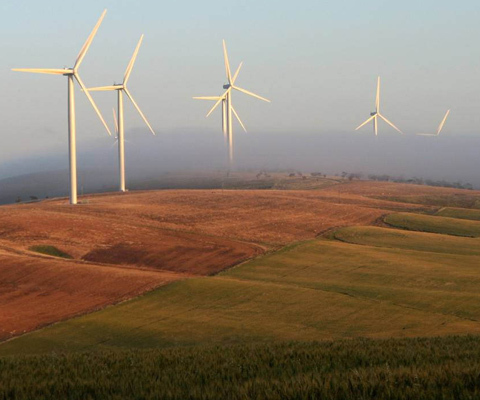
Clements Gap Wind Farm in the South Australian countryside (Credit: David Clarke via Flickr).
First-time visitors to Australia are often drawn to the big city attractions of Sydney and Melbourne or the fabulous beaches of Queensland’s Gold Coast. I’ve always had a soft spot for Adelaide in South Australia, a city built more on a human scale, where downtown can be easily navigated on bike, foot or tram. For me, Adelaide’s greatest attraction is a huge market right in the city’s centre.
When I first visited Adelaide in 1993, I met Mike Rann, a young, charismatic aboriginal affairs minister in South Australia’s Labor government. His party lost the election that year, but Rann later became party leader and then state premier in a minority government in 2002. I met him again in 2003 when he outlined ambitious plans to address climate change by aggressively moving South Australia into renewable energy. Wind and solar were the obvious opportunities, but he was also enthusiastic about “hot rocks”, superheated pockets that could create steam to drive turbines for electricity.
Rann proudly introduced me to the Youth Conservation Corps. Young people in this program are trained to restore land overgrazed by sheep or cattle, plant trees and make wildlife inventories. Rann surprised me by dedicating 45 hectares of reforestation land as Suzuki Forest.
I met young people working on “my” forest who enthusiastically told me about the number and variety of birds they’d seen that day, described plant species and talked about how many trees they had planted. Many were street kids, inspired by the chance to learn about nature and conservation and proud to be re-greening the area. I was impressed by their passion and eagerness. They believed in what they were doing and it provided a small income to get them off the streets.
My Adelaide visit that year ended at the World of Music and Dance festival, or WOMAD, a marvelous annual event where I heard the late Richie Havens sing his famous song “Freedom”. To top it off, I met Uncle Lewis O’Brien, a Kaurna elder who honoured me with the name Kaurna Mayu (mountain of a man).
I kept in touch with Mike Rann over the years. He was re-elected with majority governments in 2006 and 2010, then resigned in 2011. Last March, I returned as a guest of WOMADelaide. Although Rann was in Italy where he is now Australia’s ambassador, his wife Sasha welcomed me back. Again, the festival was a wonderful gathering of local and visiting musicians and dancers (including two groups from Canada), and to my delight, Uncle Lewis is alive and welcomed us to his country.
In Adelaide, I met Ian Hunter, South Australia’s environment minister, who boasted of his state’s tremendous progress in renewable energy. South Australia gets 40 per cent of its electricity from solar and wind and hopes to reach 50 to 60 per cent within a few years. The area is blessed with abundant sunlight, but few jurisdictions have committed to solar as aggressively and successfully as South Australia. From my hotel room, I looked down on a factory roof covered in rows of solar panels, which are now mounted on one of every four houses.
I also returned to Suzuki Forest. I was delighted and amazed at the variety and size of plants and trees, and the birds that now flourish among them. Perhaps my forest has been protected by neighbouring Schwarzenegger Forest!
Despite the impressive work in South Australia, most of the country is caught between the terrible reality of climate change — droughts, massive fires and dying reefs — and continued pressure to serve the economy by relying on fossil fuels, including recently approving the world’s largest coal mine.
Australia’s centre-right Liberal government under Prime Minister Tony Abbott gutted the previous government’s actions on climate change, disbanding the Climate Commission headed by world-renowned climate expert Tim Flannery in 2013 and cancelling Australia’s modest carbon price in 2014. Fortunately, the public started funding Flannery’s work, and the commission was reborn as the independent Climate Council. Abbott was booted by his own party after a short reign.
Nevertheless, the country — like much of the world — is in the throes of deciding whether to act seriously to reduce the threat of climate change. South Australia shows that many opportunities exist to do so.
Hey! Want more DSF? Join David Suzuki on Facebook

June 22, 2016
Who tests consumer goods for safety?

Substances used in some consumer products pose risks to human health. (Credit: Lindsay Coulter)
A recent audit found Health Canada isn't doing enough to protect Canadians from hazardous chemicals in everyday products.
This is not breaking news to you. And maybe it's the main reason you:
Make home cleaners, like dish and laundry soap
Make personal-care products, like deodorant and toothpaste
Avoid cheap loot-bag goodies and children's jewelry
Became a "fragrance" and "parfum" ingredient list detective
Federal environmental watchdog report findings:
Cosmetics and household products need more safety oversight. (Perhaps this explains how harmful microbeads made it into your toothpaste, onto store shelves and then into the ocean and aquatic species?)
Canada should align its regulations with the European Union, which has made companies label products that contain any of the known 26 fragrance allergens since 2003. (The David Suzuki Foundation made this same recommendation in 2011 with Failing the Sniff Test: Chemicals in fragranced products remain a mystery!)
Gaps in the Consumer Product Safety Program -- which is designed to detect risks to human health -- are problematic.
No regular tests are conducted for heavy metals (and contaminants). Did you know that for some heavy metals, like lead, there are no safe levels?
Sunscreen products can be unsafe and their labels misleading.
More product testing is needed, and consumers should be informed that terms like "hypoallergenic" or "unscented" don't necessarily mean the product is healthy or safe.
The good news?
Health Canada will review its plan, and may include testing of cosmetics for banned or restricted substances. It may also require companies to confidentially disclose a full list of ingredients, instead of hiding behind "trade secrets".
Until then, continue to shop for products free from the Dirty Dozen, including "fragrance", and clean your home with food-grade ingredients!
And sign up for my digest to get your monthly dose of "green" inspiration, which will help reduce your exposure to toxic chemicals in consumer goods.
Sincerely,
Lindsay Coulter, a fellow Queen of Green
Hey! Want more DSF? Join David Suzuki on Facebook

June 21, 2016
David Suzuki Foundation statement: Environmental reviews welcome
The David Suzuki Foundation welcomes the federal government's announcement yesterday that it will review key pieces of environmental legislation, including returning provisions stripped away in 2012's omnibus budget bill.
Strengthening legislation such as the Canadian Environmental Assessment Act provides an opportunity for the federal government to make Canada the environmental and climate action leader that Canadians want. "This is Canada's chance to be an international leader and build a credible assessment process that shifts us away from oil, coal and natural gas by 2050 as committed to in the Paris Agreement," said David Suzuki Foundation science and policy director Ian Bruce.
"Canada's environmental assessment process must include a real climate test that assesses the viability of fossil fuel project proposals as we look forward to a zero-emission Canada by 2050. Strong processes, panels and regulations are needed to move Canada from polluting fossil fuels to cleaner and safer sources of energy," Bruce said.
The Foundation is encouraged that the government is considering restoring environmental protections lost in the 2012 omnibus bill. A strong Canadian Environmental Assessment Act and habitat protections under the Fisheries Act are fundamental to maintaining Canada's rich ecosystems, diverse wildlife and healthy communities.
"These reviews represent an excellent opportunity for Canadians to provide input that will shape the way this country makes decisions that affect the environment," Bruce said.
30
Media contact:
Ian Bruce, Director of Science and Policy, David Suzuki Foundation
Phone: 604-306-5095
Hey! Want more DSF? Join David Suzuki on Facebook

June 16, 2016
Feed-in tariffs help renewable energy grow

(Credit Chuck Coker via Flickr)
In the early 1990s, Germany launched Energiewende, or "energy revolution," a program "to combat climate change, avoid nuclear risks, improve energy security, and guarantee competitiveness and growth." Renewable energy grew from four per cent in 1990 to more than 27 per cent in 2014, including a significant increase in citizen-owned power projects, according to energy think tank Agora Energiewende.
Germany's greenhouse gas emissions dropped by 27 per cent during that time. Its goal is to reduce emissions 40 per cent from 1990 levels by 2020 and more than 80 per cent by 2050. Polls show that 90 per cent of Germans like the program -- even though it means paying higher rates for electricity.
There's good reason for this widespread support. The primary technologies of wind and solar have become cost-competitive with conventional energy sources. Variable renewable sources and "flexibility options" for conventional and renewable power generation are making baseload power obsolete -- which means the system is geared to wind and solar rather than nuclear or coal. It's one of the most reliable energy systems in the world. And it's created jobs and revenue.
_Energiewende _hasn't solved all of Germany's emissions and energy issues. Electricity rates are among Europe's highest, although they're expected to come down as more renewable energy becomes available, and efficient usage means "actual costs to households are comparable to countries with lower prices but higher consumption levels." The country still gets more energy from coal than renewables, transportation and heating consume significant energy from conventional sources, and heavy industry makes Germany one of Western Europe's highest emitters. Opposition from power utilities and coal companies, with consequent government compromises, has also slowed progress. But a range of initiatives and tools has put Germany on track to meeting its long-term climate commitments.
One tool Germany used to achieve its rapid progress was a feed-in tariff, which guarantees renewable energy producers -- individuals, businesses, community organizations and power companies -- access to the grid and payment from power utilities for energy they put into the system. At first, the tariff wasn't enough to cover costs, but in 2000 Germany introduced a law that guaranteed feed-in tariffs for 20 years at prices high enough for producers to profit. As renewable energy costs drop and more is brought into the system, tariffs go down.
Feed-in tariffs are in place in Ontario, and in many countries worldwide. The Pembina Institute notes they're effective for several reasons. They "reward actual production" rather than just installation, they minimize development investment risks and "facilitate access to financing," and they encourage small, medium and large producers and "community and local ownership and engagement, minimizing opposition to projects."
They also "encourage renewable power producers to use the most efficient technology, driving down costs by fostering industrial competition," and while they cause short-term electricity price hikes, those stabilize over time as costs and risks of conventional power generation and volatile fossil fuel markets are reduced. Income paid through tariffs "more than offsets any electricity price increases" for those who generate renewable energy. And if the full environmental and health damages of fossil fuels are considered, renewables are an even better bargain.
Many jurisdictions with feed-in tariffs have become leading exporters of renewable energy technology, creating local jobs and strengthening economies -- with little or no government spending! Feed-in tariffs vary in rates and designs according to what types and scales of technologies governments want to encourage and where they want them located, which means they must be carefully designed.
Massive centralized power sources are not efficient and are quickly becoming outdated. Some power is lost when it has to be transmitted over long distances, and large sources usually keep operating even when power isn't required. Using smart grids and distributed renewable energy with demand-management systems allows energy to be dispatched where and when it's needed, most often over shorter distances, and a variety of power sources makes them more reliable, as large-scale power outages are less frequent.
Burning finite fuels in huge plants to generate electricity is no way to power the future. Meeting global commitments to reduce greenhouse gas emissions and slow global warming requires a transition from fossil fuels to renewable energy. Feed-in tariffs are an effective way for governments to encourage that shift.
Hey! Want more DSF? Join David Suzuki on Facebook

David Suzuki Foundation encouraged by new transit investment in Metro Vancouver
VANCOUVER -- Today's transit-funding announcement by the federal and B.C. governments and Metro Vancouver mayors is a positive step on the road to securing long-term investment in transit. Although the Phase 1 funds only ensure funding for the first three years of the 10-year plan developed by the region's mayors, they are enough to guarantee that key infrastructure projects can begin to move forward.
"We are pleased to learn that the province, mayors and federal government have reached an agreement for the first phase of funding for transit in Metro Vancouver," said David Suzuki Foundation science and policy director Ian Bruce. "It's good to see a deal for this first phase of transit investment, but we need a long-term commitment and increased investment."
Recent research by the Foundation shows investment in transit is desperately needed to relieve traffic congestion in Metro Vancouver and to address years of underfunding. Our recent report, "Breaking gridlock: B.C.'s transit investment deficit and what can be done to fix it", shows the B.C. government identified in 2008 that the province needed to invest $4.75 billion in transit funding, but only 23 per cent of these funds have materialized.
"We commend the federal government for catalyzing this deal to improve and expand Metro Vancouver's transit network with its commitment to 50 per cent funding," Bruce said. "We hope this day marks the end of requiring plebiscites to approve transit funding."
To download the full report visit: http://www.davidsuzuki.org/publications/reports/2016/breaking-gridlock-bc-transit-investment-deficit-and-what-can-be-done-to-fix-i/
For more information:
David Suzuki Foundation - Steve Kux, 604-374-4102
David Suzuki Foundation - Ian Bruce, 604-306-5095
Hey! Want more DSF? Join David Suzuki on Facebook

June 15, 2016
When is wildlife no longer wild?

(Credit: Nathanael Coyne via Flickr)
I became an environmental activist while working as a summer student at a zoo. As an animal lover, it seemed like a perfect job, and I felt lucky to get it. But I quit midway through my fourth summer, unable to stomach the despair and boredom that greeted me from behind the cage bars every day.
My zoo experiences led me to my first job at an environmental organization, Zoocheck, and onto my current work of over 15 years -- advocating for wildlife habitat protection. I've pushed science-based protection measures for all sorts of species -- from snapping turtles to right whales to monarch butterflies -- but a big focus of my work has been boreal woodland caribou.
You can imagine my feelings on learning last week that Alberta is planning to manage the highly imperilled Little Smoky caribou population by building a 100-square-kilometre enclosure while allowing logging and failing to put limits on fracking-related disturbances.
To be fair to Alberta, the province paired this with an announcement of significant protected areas for four caribou populations in the north, and the plan contains some progressive measures. The government is at least taking action. Over the past two decades, provincial leaders did almost nothing to curtail industrial disturbance in caribou habitat. In 2011, the Little Smoky caribou range was assessed as over 95 per cent disturbed by human activities. Many of Alberta's caribou populations have slid precipitously close to local extinction because of the impact of industrial activities and the ensuing changes to predator-prey relationships they facilitate.
Amid this landscape of industrial disturbance, the announcement of permanent enclosures as a recovery tool is, to me, a terrible new milestone in our collective national journey of unsustainable boreal caribou management. It is a "solution" that will ultimately cause additional harm, like other management strategies the province employs, such as predator control.
Alberta continues to kill wolves and other predators in the name of caribou management. As I've expressed elsewhere, this approach scapegoats predators that have co-evolved with their caribou prey for thousands of years before humans started building permanent roads and seismic lines in the boreal forest, thereby altering predator-prey dynamics.
Although the 100-square-kilometre enclosure is obviously bigger than the small cages that caused animals distress in my city zoo, and it would likely succeed in stopping caribou from being prey in the food chain, I believe that permanent enclosures for wild animals are not an appropriate management tool.
In biologist Mark Hebblewhite's words, the enclosure will render these caribou "semi-domestic". A primary component of suitable caribou habitat is its ability to meet caribou's need to disperse and avoid predation, and caribou in turn are integrally shaped by interactions with their habitat and the predators that they try to avoid.
In the same way that a fat, bored tiger at a zoo ceases in many ways to be a tiger, so too would woodland caribou kept in pens cease to truly be caribou.
The federal government concluded in the Boreal Caribou Recovery Strategy that caribou recovery is technically and biologically feasible. What is needed is political will and active restoration of caribou's highly degraded habitat, not permanent fencing and continued logging.
Hey! Want more DSF? Join David Suzuki on Facebook

June 13, 2016
How you catch tuna matters
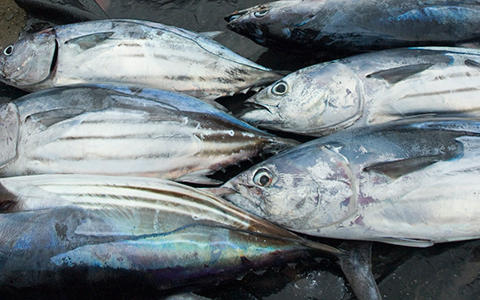
(Credit: WorldFish via Flickr)
Canadians who love eating tuna may not be so thrilled when they learn how much of it is caught unsustainably. SeaChoice delved into tuna and other seafood in its Taking Stock report, the first comprehensive look at Canadian seafood imports and exports. The report finds that Canada exports more seafood than it imports, and more of the exports than imports are sustainable.
Canada imports albacore, bigeye, yellowfin, bluefin and skipjack tuna. Skipjack tuna is among Canada's top three red ranked -- or "avoid" -- seafood imports, along with farmed shrimp and salmon. These three make up more than 80 per cent of red-ranked imports.
Most tuna (including skipjack) is caught using a purse seine, where cup-shaped nets are dropped into water, and the net's rim is pinched at the top to trap fish. While some of the world's tuna is caught using sustainable practices, most imported skipjack is caught using fish-aggregating devices. These devices are basically buoys and floats on the ocean surface that attract tuna but also lure bycatch such as juvenile tuna, sea turtles and sharks, making the fishery unsustainable.
Using purse seines without fish-aggregating devices reduces the level of bycatch, making this tuna yellow-ranked ("some concerns"), according to SeaChoice. Tuna caught using pole-and-line methods has a green "best choice" ranking.
If you're concerned about the health of oceans and marine life, make an ocean-friendly decision and buy tuna with a green SeaChoice label at participating retailers. Check out Greenpeace Canada's canned tuna sustainability rankings to see how your favourite brand stacks up.
Hey! Want more DSF? Join David Suzuki on Facebook

June 9, 2016
Oceans of reasons to protect what we love
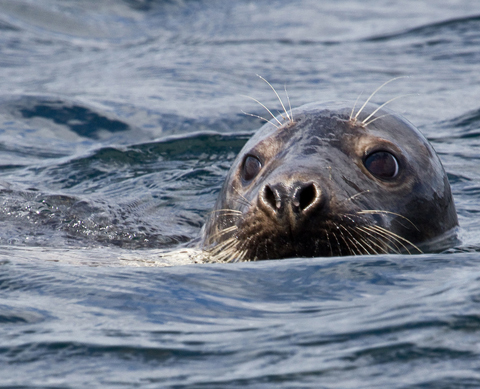
(Credit: Richard Towell via Flickr)
June 8 marked World Oceans Day, but what if we celebrated oceans every day? Covering more than 70 per cent of Earth's surface, oceans, more than anything, define our small blue planet. We should celebrate their complex and vibrant ecosystems, life-sustaining services, calming effects and unimaginable diversity, much of which we have not yet even discovered.
Summer is an especially rich time for ocean life. As days grow longer here in the northern hemisphere, abundance builds from the microscopic level as photosynthesis triggers phytoplankton to bloom, providing food for zooplankton such as krill. Krill then feed small fish like herring and sand lance, which in turn feed larger fish, dolphins and whales. This marine food web relies on a scale of unfathomable interconnectedness -- yet it's easily disrupted.
Climate change, overfishing, pollution, industrial activity, shipping and events like El Niño are putting oceans under stress like never before. Sea levels are rising, fish migrating, oceans acidifying, coral reefs bleaching and phytoplankton disappearing, and populations of iconic marine mammals like killer whales are plummeting.
The news for oceans hasn't been good lately, and that worries Canadians. It's not just coastal communities that are defined and affected by oceans. Canada has the longest coastline in the world, and people throughout Canada want the seas, and all the marine life they support, to be healthy.
Fortunately, solutions to many ocean woes are within our grasp, although governments have been frustratingly slow to act over the past decade. Canada could protect marine areas, restore protective laws, conserve wild salmon and control open net-pen fish farms.
Our country's commitment to protect 10 per cent of its marine environment by 2020 is a good start, but if we followed countries like Australia and the U.S, we'd aim higher. Canada could act to transform its reputation from laggard to leader on marine protection, plan for ocean management with an understanding of how ecosystems work and incorporate traditional Indigenous knowledge to give wildlife a chance to thrive.
Pacific salmon, crucial to West Coast ecosystems, are especially in need of protection, but their numbers continue to decline. Few natural events are as dramatic and moving as millions of salmon returning from the oceans to spawn in streams, rivers and lakes. Driven by the imperative to reach spawning beds before their genetically programmed deaths, salmon fight past predators, hooks, nets and pollution, retaining the power to leap river barriers shortly before their lives end. Bears, eagles and other wildlife feed on the salmon, leaving their nitrogen-rich wastes to fertilize the magnificent coastal rainforests.
For almost 40 years, Canadian laws protected fish such as salmon and the water bodies where they live and spawn. The Fisheries Act was one legal tool to protect lakes and rivers, which offer benefits such as clean drinking water to nearby communities. But the federal government removed habitat protections from the act in 2012. Fish that aren't part of a defined, often commercial, fishery will remain vulnerable until protection is reinstated.
We still have much to learn about wild salmon, but we can take some practical steps to support them. A lot of time and money, about $37 million, was spent on one of the most comprehensive reviews of Pacific salmon management ever undertaken. It's been four years since B.C. Supreme Court Justice Bruce Cohen completed his Inquiry into the Decline of Sockeye Salmon in the Fraser River, yet few of his recommendations have been implemented. Fish biologists say that Canada's Wild Salmon Policy, adopted in 2005, also offers good management measures, but it isn't being followed either.
Salmon face other threats. Concerns over disease spread from salmon farms to wild salmon were heightened recently with the discovery of a new pathogen in farmed salmon. The virus connected to this disease plagues Norway's farmed salmon and is now common in penned Atlantic salmon and wild fish near B.C. fish farms.
Salmon are often indicators of the overall health of the ecosystems in which they live. When marine ecosystems are healthy, they provide food, jobs, recreation and culture. They are foundational life forces for whales, bears, eagles, forests and humans. We should celebrate their life-giving capacity by treating them with respect -- not just on World Oceans Day, but every day!
Help protect Canada's oceans.
Send a message to the federal government.
Hey! Want more DSF? Join David Suzuki on Facebook

David Suzuki's Blog
- David Suzuki's profile
- 247 followers


